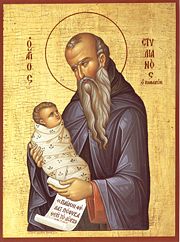Difference between revisions of "Stylianos of Paphlagonia"
m (links) |
m (link) |
||
| Line 13: | Line 13: | ||
|- | |- | ||
|'''Venerated in''' | |'''Venerated in''' | ||
| − | |[[Roman Catholicism]], [[Eastern Orthodoxy]] | + | |[[Roman Catholic Church|Roman Catholicism]], [[Eastern Orthodoxy]] |
|- | |- | ||
|'''Major shrine''' | |'''Major shrine''' | ||
Revision as of 21:04, November 28, 2009
| Saint Stylianos | |
|---|---|

| |
| of Paphlagonia | |
| Born | about 550, Adrianopolis, Paphlagonia |
| Died | Unknown, Paphlagonia |
| Venerated in | Roman Catholicism, Eastern Orthodoxy |
| Major shrine | None |
| Feast | November 26 |
| Attributes | Child wrapped in swaddling |
| Patronage | Children, both born and unborn, and Orphans |
| Prayer
Holy Stylianos, thou wast a tower of abstinence and an unshaken pillar of the Church. Dedicated to God from thy youth, thou didst become a dwelling-place of the Spirit. O righteous Father, intercede with Christ our God to grant us His great mercy. [1] | |
Saint Stylianos (Latin: Stylianus, Greek: Στυλιανός, English: Stylian) was born during the 6th century in Adrianopolis in the province of Paphlagonia (in modern day Turkey) into a very wealthy family. At a young age, Stylianos joined the hermits of the desert with a view toward cleansing his soul through a period of meditation and prayer, as well as through association with men likewise pledging their lives to Jesus Christ. Unlike most other hermits, however, he did not withdraw from society altogether, preferring to go among the people for whatever good he might do, and then returning to his little cave for rest and prayerful meditation.
According to the church tradition, one night while he prayed for guidance in helping others, Stylianos felt a divine presence and was consumed by the great glory of the Holy Spirit, emerging from his cave the next day with a spirit of exultation and serenity he had never known before. In his customary rounds, wherein he counseled and comforted, he felt compelled to place his hand on a stricken child, something he had not up to that time dared to do; he felt the power of the Lord being transferred to the ailing youngster through his extended arm. The child immediately recovered, and thenceforth Stylianos was sought after by every suffering soul for miles around, young and old. His cave became a magnet for the sick and suffering, many of whom received complete cures not only through the power in this man but through their own faith as well, without which a sufferer’s case was hopeless.
During this period, Stylianos concerned himself primarily with children, not just the physically afflicted but also with those who were in need of spiritual guidance. Families from all walks of life were said to have entrusted to Stylianos the enlightenment of their children, and he was forced to seek out larger headquarters and to recruit from the ranks of his hermit friends the assistance needed to tend to so many. His was probably the first day-care centre in the world, where mothers could safely leave their children while tending to other matters of the home.
Stylianos was to become the patron saint of children yet to be born, owing to stories of his miraculous intercession for a young woman who helped him with children but could bear none of her own. When the woman conceived, her husband out of sheer joy spread the word of this miracle, and before long many barren women came to the great hermit. Those whose faith in Jesus Christ was genuine became fertile.
The cheerful countenance of Stylianos was his hallmark, because he was reported to always to be smiling. According to oral histories, he was approached by greedy mercenaries with all manner of propositions for commercializing his talents and reaping a tidy fortune, but for these people he always had the same answer: that he had been paid in advance for his services when the serenity of the Holy Spirit came upon him. He would smile as they left. He lived to a ripe old age, and it is said that when he was buried his countenance still beamed with a faint smile from the light of the Lord.
Sources
Categories > Church History
Categories > Church History
Categories > Church History
Categories > Liturgics > Feasts
Categories > Liturgics > Feasts
Categories > Liturgics > Feasts
Categories > People > Monastics
Categories > People > Saints
Categories > People > Saints > Byzantine Saints
Categories > People > Saints > Saints by century > 7th-century saints